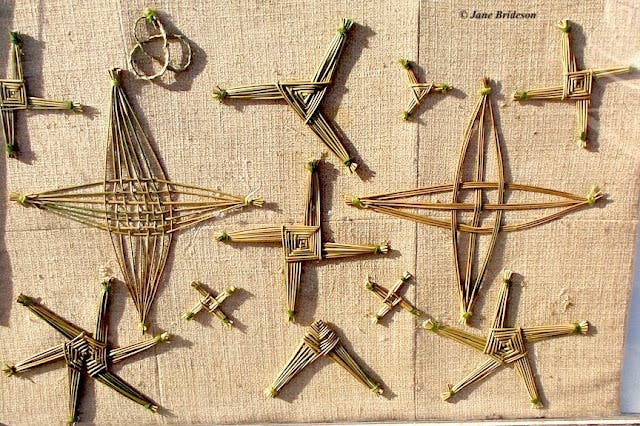Brigid's Cross for Imbolc
How Do Love Spells Work?
- Love spells focus intent through ritual tools, timing, and symbols—like the Brigid’s Cross at Imbolc—to attract love, healing, and protection.
- Imbolc (St. Brigid’s Day) marks renewal and growing light; weaving a Brigid’s Cross anchors intentions for home blessing, romance, and fresh starts.
- Use rushes, straw, paper, or lavender stalks; personalize with ribbons, charms, and written affirmations for targeted results.
- Display your cross above doors or on your altar to guard against negativity and to amplify rituals for love, creativity, and prosperity.
- Pair your Brigid’s Cross with professionally cast love spells and protection work to compound results and accelerate manifestation.
Imbolc, also celebrated as St. Brigid’s Day, welcomes the first stirrings of spring, creative fire, and renewal. At the heart of this Sabbat is weaving the Brigid’s Cross—a protective charm believed to bless homes with love, abundance, and safety.
Traditionally crafted from rushes, modern practitioners also use straw, paper, or fragrant lavender. Each carries its own energy and symbolism—making this ritual both accessible and deeply personal.
Want fast, focused results? Pair your ritual with professional spellwork. Shop real love spells that work today or buy love spells online from verified spell casters and amplify your Imbolc intentions.
✨ Visit Our Spell Shop — Start Manifesting Your Blessings Now! ✨Weaving your own Brigid’s Cross is a beautiful way to invite protection, prosperity, creativity, and love into your space. Gather your materials and follow the step-by-step guide below to align with Imbolc’s returning light.
Looking to boost romance in tandem with your Imbolc work? Explore our curated love spells collection and set powerful intentions for new beginnings.
 Traditional and modern Brigid's Crosses for Imbolc—woven from rushes, straw, or lavender.
Traditional and modern Brigid's Crosses for Imbolc—woven from rushes, straw, or lavender.
Brigid’s Cross Meaning: Imbolc Protection, Love Magic, and Renewed Energy
From Goddess Brigid to St. Brigid: A Living Tradition
The Brigid’s Cross originates in Celtic spirituality, honoring Brigid, the triple goddess of the hearth, healing, and inspiration. With Christianization, the custom flowed into St. Brigid’s Day on February 1–2, preserving the cross as a bridge between ancient folk magic and modern practice.
Why We Weave at Imbolc
Each Brigid’s Cross is crafted to:
- Protect the home from fire, malice, and bad luck
- Attract love, abundance, and healing into the household
- Honor the season’s light, fertility, and creativity
- Mark the turning of the Wheel at Imbolc / Candlemas
The Heart of Imbolc: Light, Love, and Renewal
Imbolc (also known as Candlemas) celebrates the return of warmth and the growing light. Weaving and blessing a Brigid’s Cross gives physical form to your intentions—renewal, protection, and loving relationships—anchored into your home.
 Woven Brigid’s Cross: detailed handiwork for powerful spiritual protection.
Woven Brigid’s Cross: detailed handiwork for powerful spiritual protection.
What You’ll Need: Traditional Materials and Modern Alternatives
Choosing Your Weaving Material
Historically, Brigid’s Crosses were woven from Irish rushes, a sacred, flexible plant. Today, choose what’s accessible and aligned with your intention:
- Straw: Soak briefly to prevent snapping; symbolizes abundance and harvest.
- Paper strips: Ideal for writing intentions; a blank canvas for design.
- Lavender stalks: Beautiful scent and soothing, protective energy.
- Cattail or sturdy stems: Any straight, flexible botanical works.
Pro tip: Select materials that resonate with your goals—love, healing, creativity, or prosperity. Each carries unique vibrations.
Tools Checklist
- 10–20 stalks, straws, paper strips, or lavender stems (12–16 inches long)
- Scissors
- Red or white twine for tying
- Optional decor: ribbons, beads, charms, dried flowers
Step-by-Step: How to Weave a Brigid’s Cross for Imbolc
 The weaving process: calm focus and intention power your Imbolc ritual.
The weaving process: calm focus and intention power your Imbolc ritual.
- Prepare: Trim all stalks to equal length (12–16"). If using straw, soak briefly to soften. Set a calm, loving intention.
- Begin: Hold one stalk horizontally. Fold a second stalk in half and wrap it over the first at a right angle, forming a corner.
- Rotate: Turn the growing cross 90° to the left. Add a folded stalk over the upright stalks. Continue alternating sides, adding a new folded stalk each time.
- Tighten center: Keep a firm grip as the central square forms. Adjust tension for a neat, secure weave.
- Tie ends: Secure each arm with red (love) or white (purity) string. Trim stray ends for a clean finish.
- Hang: Add a loop to display above a door, window, hearth, or on your altar.
 Finished Brigid’s Crosses—each one a vessel for blessing, protection, and love.
Finished Brigid’s Crosses—each one a vessel for blessing, protection, and love.
Personalize the Magic: Design Ideas and Modern Uses
Creative Ways to Empower Your Cross
- Weave in red, pink, or gold ribbons for love, joy, or prosperity.
- Add dried rose petals to bless romance and tenderness.
- Attach charms, beads, or crystals aligned with your goals.
- Write intentions on paper strips and weave them into the arms.
Want to intensify attraction energy? Pair your ritual with the Attraction Love Spell for focused magnetism.
Where and How to Use It
- Hang above entryways for classic protection.
- Place on your altar as an Imbolc centerpiece.
- Incorporate in love and healing work alongside the Unconditional Love Spell.
- Gift to loved ones as a heartfelt blessing.
Exploring more ways to enhance romance? Visit our Love Spells Collection for expert spellcasting options that sync beautifully with Imbolc.
Five Powerful Ways to Work with Brigid’s Cross at Imbolc
1) Love Altar Amplifier
Place your handwoven cross between pink or red candles to invite love, unity, and blessing into relationships. For reconciliations or deep healing, align with the Reconciliation Love Spell.
2) Healing Meditation Focus
Hold the cross in quiet meditation. Visualize Brigid’s flame cleansing old wounds and rekindling hope. Repeat: “With Brigid’s light, I am renewed in love and spirit.”
3) Manifestation Weave
Write wishes on parchment and weave them into the arms. Each glance at your cross becomes an affirmation of your goal fulfilled.
4) Family Harmony Ritual
Invite each family member to add a stalk or ribbon while setting a shared intention for closeness and fresh starts. Display the cross in your communal space.
5) Home Cleansing Walkthrough
Gently waft your cross through each room at Imbolc, envisioning stagnant energy dissolving. Burn a cleansing incense for extra potency.
Imbolc Community: Share, Celebrate, and Keep the Tradition Alive
Hosting an Imbolc gathering—online or in person—creates connection and shared purpose. Trade design tips, weave together, and bless each other’s crosses for collective momentum.
Gifting a Brigid’s Cross with a handwritten blessing is a loving way to offer protection and romance energy to friends, partners, or new couples.
Brigid’s Cross in Modern Witchcraft
The Brigid’s Cross endures as a symbol of creativity, magic, and protection. Many modern practitioners blend it with tarot, crystal grids, and aromatherapy for layered rituals. To reignite a bond, consider the Bring Back Lost Lover Love Spell as you consecrate your cross.
Success Stories: Brigid’s Cross Blessings ⭐⭐⭐⭐⭐
Frequently Asked Questions—Brigid’s Cross & Imbolc
Expand Your Imbolc Magic: More Uses for Brigid’s Cross
Candle Charging for Attraction
Set your cross beside a red or pink candle and visualize the flame charging your home with warmth and desire. For a romantic boost, explore our Attraction Love Spell.
Gifting a Blessing
Gift a cross with a handwritten affirmation to a partner or loved one. It’s a lasting token of protection and devotion.
Dream Magic
Hang your cross near the bed to promote restful sleep or prophetic dreams during Imbolc. Pair with the Dream of Me Spell for deeper connection in the dream space.
Eco-Friendly Practice
Use biodegradable materials and return last year’s cross to the earth with gratitude when you craft a new one.
Honoring Ancestors
As you weave, name the ancestors and teachers who kept this tradition alive. Offer thanks and invite their guidance.
About the Author
Conclusion — Weave Protection, Manifest Love, and Welcome Imbolc’s Light
The Brigid’s Cross is a living link between ancient wisdom and your modern home. By weaving and blessing your cross, you invite renewal, protection, and love to take root in your space.
Set your intention, craft with care, and—if you desire faster results—combine your ritual with expert spellwork. Your next chapter of warmth, harmony, and romance can begin today.
💖 Begin Your Ritual—Shop Imbolc & Love Spells Today! 💖🔴 Need Clarity on your Situation?



